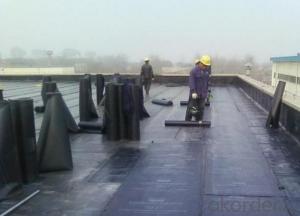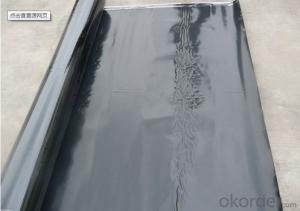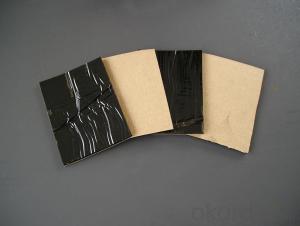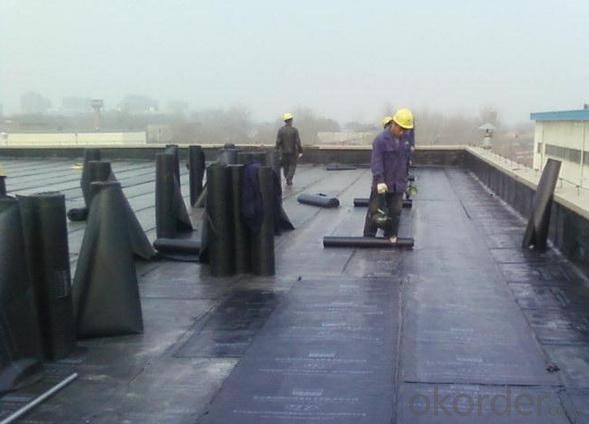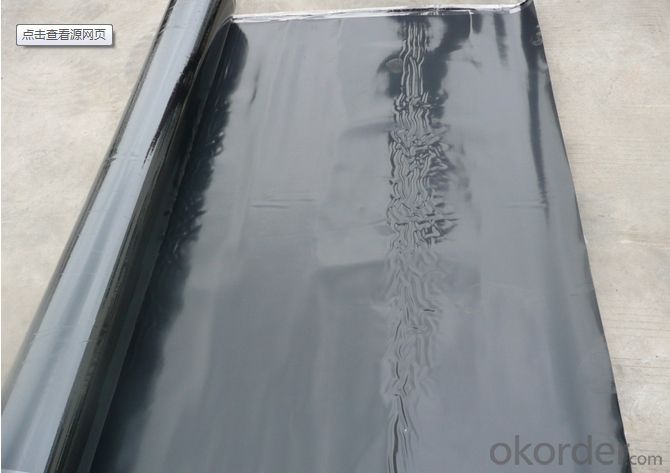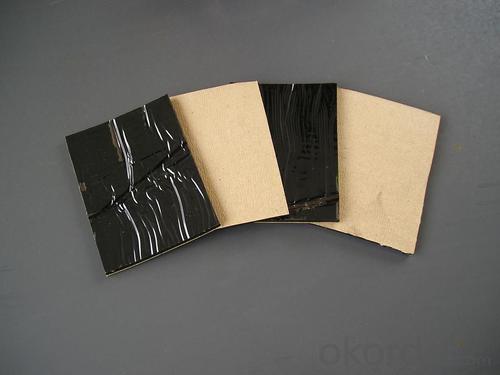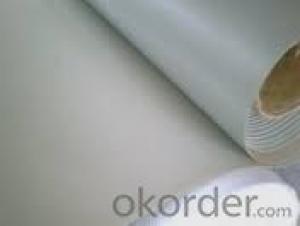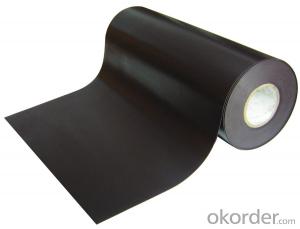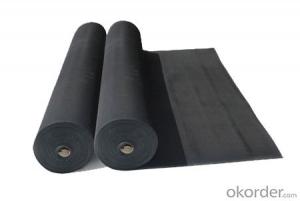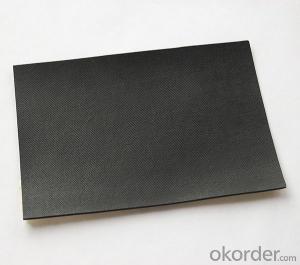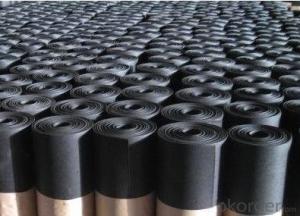EPDM Rubber Weldable Waterproofing Membrane Underground
- Loading Port:
- China main port
- Payment Terms:
- TT OR LC
- Min Order Qty:
- 5000 m²
- Supply Capability:
- 100000 m²/month
OKorder Service Pledge
OKorder Financial Service
You Might Also Like
Introduction for EPDM Waterproofing Membrane:
Waterproof membrane for roof adopt the international advanced level cold feed extrusion continuous vulcanization process for the integration of production equipment and technology so that the system density of products is better and the products have no bubble sooth surface, no performance difference between vertical and horizontal.
Characteristic of EPDM Waterproofing Membrane:
1>Excellent anti-aging performance, service life up to 50 years
2>Working well with in -40°C to 100°C,it can be constructed with a single layer in ambient temperature. 3>Waterproofing on various kinds of underground project,industrial of civil buildings and structures. 4>high extension rate, high tensile strength, small size changes at heat treatment
5>Good plant roots penetrability resistance and can be made waterproofing layer of planting roof
6>Special modified molecular structure ,effectively resolving the current domestic and foreign glue joint problem . 7>Good low temperature flexibility, and good performance of adapting to ambient temperature changes. 8>Convenient application ,solid joint, no environment pollution
9>chemical corrosion Resistance, can be used for special occasions
Specification of EPDM Waterproofing Membrane:
No. | Item | Unit | Standard Request | |
1 | Variation in Dimension | Thickness | % | ±10 |
Width | % | ±1 | ||
Length | % | No Negative Value | ||
2 | Tensile Strength at Break(Normal Temperature) | Mpa | ≥7.5 | |
Tensile Strength at Break(60ºC) | Mpa | ≥2.3 | ||
3 | Elongation at Break(Normal Temperature) | % | ≥450 | |
Elongation at Break(-20ºC) | % | ≥200 | ||
4 | Tearing Strength | KN/m | ≥25 | |
5 | Water Impermeability(30min) | * | 0.3Mpa Impermeability | |
6 | Bend Temperature | ºC | ≤-40 | |
7 | Heating Expansion/Shrinkage | Expansion | mm | ≤2 |
Shrinkage | mm | ≤4 | ||
8 | Hot Air Aging 80ºC x168h | Unchanging of Tensile Strength at Break | % | ≥80 |
Unchanging of Tearing Strength | % | ≥70 | ||
9 | Property of Anti Alkali 10% Ca(OH)²x 168h normal temperature | Unchanging of Tensile Strength at Break | % | ≥80 |
Unchanging of Tearing Strength | % | ≥80 | ||
10 | Elongation 40%,500x102 | * | No Crack | |
11 | Artificial Aging | Unchanging of Tensile Strength at Break | % | ≥80 |
Unchanging of Tearing Strength | % | ≥70 | ||
Appearance of 100% elongation | * | No Crack | ||
FAQ of Waterproofing Membrane
a.Can we get some samples before place order?
Answer: We can send the free samples to you by freight collect.
b.How many years can your PVC membrane guarantee?
Answer: We will guarantee the quality for 5 years at least.
c.Which countries you ever export the product?
Answer: We export the PVC membrane to South Africa, Middle east and even European countries.
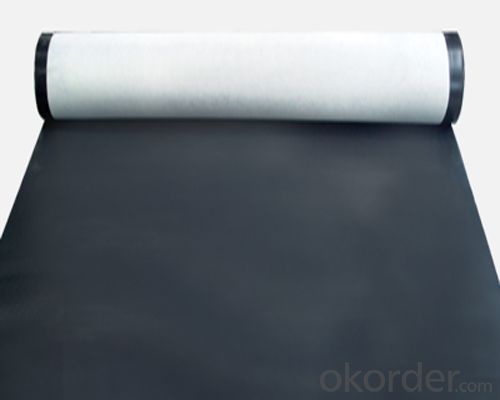
- Q: Does a waterproofing membrane require a topcoat or sealer?
- Yes, a waterproofing membrane typically requires a topcoat or sealer to enhance its durability and provide additional protection against external elements such as UV radiation, abrasion, and chemical exposure. The topcoat or sealer helps to further seal the membrane and extend its lifespan, ensuring long-term waterproofing effectiveness.
- Q: Can a waterproofing membrane be used for parking garage ramps and driveways?
- Indeed, parking garage ramps and driveways can benefit from the utilization of a waterproofing membrane. Due to their constant exposure to water, moisture, and various environmental factors, these areas are susceptible to structural degradation over time. Nonetheless, the application of a waterproofing membrane establishes a barrier that effectively obstructs water infiltration, safeguarding the underlying concrete or asphalt from deterioration. Consequently, this practice prolongs the lifespan of the ramps and driveways, diminishes maintenance expenditure, and amplifies overall durability. Moreover, the implementation of a waterproofing membrane also deters water from permeating the subterranean parking zones, thereby averting potential water-related harm and ensuring a secure and dry environment for both vehicles and pedestrians.
- Q: Does a waterproofing membrane require any specific cleaning methods?
- Yes, a waterproofing membrane typically requires specific cleaning methods. It is important to avoid using abrasive cleaners or tools that may damage the membrane. Instead, gentle cleaning solutions and soft brushes or cloths should be used to remove dirt and debris without compromising the membrane's integrity. Regular maintenance and cleaning will help prolong the lifespan and effectiveness of the waterproofing membrane.
- Q: Can a waterproofing membrane be used in conjunction with sustainable construction materials?
- Yes, a waterproofing membrane can be used in conjunction with sustainable construction materials. Sustainable construction materials such as recycled content, low VOC (Volatile Organic Compound) products, and green building materials are increasingly being used in building projects to reduce environmental impact. Using a waterproofing membrane in combination with sustainable materials helps ensure the longevity and durability of the structure while also maintaining its eco-friendly attributes.
- Q: Can a waterproofing membrane be used for a stadium roof?
- Yes, a waterproofing membrane can be used for a stadium roof. Waterproofing membranes are commonly used in construction projects, including roofs, to prevent water infiltration and protect the underlying structure from water damage. The membrane acts as a barrier against moisture and is designed to withstand the harsh outdoor elements, such as rain, snow, and UV radiation. By applying a waterproofing membrane to a stadium roof, it can help ensure that the roof remains watertight and prevents leaks, which is crucial for maintaining the integrity of the stadium and protecting spectators, equipment, and facilities inside. Additionally, waterproofing membranes are available in various types and materials, allowing for customization to meet the specific requirements and design of the stadium roof.
- Q: Can waterproofing membranes be installed on uneven surfaces?
- Yes, waterproofing membranes can be installed on uneven surfaces. In fact, one of the advantages of waterproofing membranes is their ability to conform to various irregularities and unevenness in the surface. These membranes are typically flexible and can be easily molded and adjusted to fit the contours of the substrate. Additionally, some waterproofing membranes have self-adhesive properties or can be applied with adhesives, allowing them to adhere to both smooth and uneven surfaces effectively. However, it is important to note that proper surface preparation is crucial for a successful installation. The surface should be clean, dry, and free from any loose materials or debris to ensure optimum adhesion and performance of the waterproofing membrane.
- Q: Can a waterproofing membrane be used in crawlspaces or basements?
- Yes, a waterproofing membrane can be used in crawlspaces or basements. These membranes are specifically designed to prevent water infiltration and are commonly used in these areas to protect against moisture, dampness, and potential water damage. They create a barrier that keeps water out, helping to keep crawlspaces and basements dry and free from water-related issues.
- Q: Can a waterproofing membrane be used in conjunction with roofing materials?
- Yes, a waterproofing membrane can be used in conjunction with roofing materials. In fact, it is commonly used to provide an additional layer of protection against water infiltration and to enhance the overall waterproofing capabilities of the roof.
- Q: Can a waterproofing membrane be installed on metal surfaces?
- Yes, a waterproofing membrane can be installed on metal surfaces.
- Q: Can a waterproofing membrane be used for stadiums and sports arenas?
- Yes, a waterproofing membrane can be used for stadiums and sports arenas. These large structures are exposed to various weather conditions and are prone to water damage. Waterproofing membranes are designed to provide a protective barrier against water infiltration and can be applied to different parts of the stadium or sports arena, such as the roof, walls, and foundation. By preventing water from entering the structure, a waterproofing membrane helps to maintain the integrity of the building, prolong its lifespan, and prevent costly repairs due to water damage. Additionally, these membranes can also provide insulation and energy-saving benefits, further enhancing the overall performance of the stadium or sports arena.
Send your message to us
EPDM Rubber Weldable Waterproofing Membrane Underground
- Loading Port:
- China main port
- Payment Terms:
- TT OR LC
- Min Order Qty:
- 5000 m²
- Supply Capability:
- 100000 m²/month
OKorder Service Pledge
OKorder Financial Service
Similar products
Hot products
Hot Searches
Related keywords
